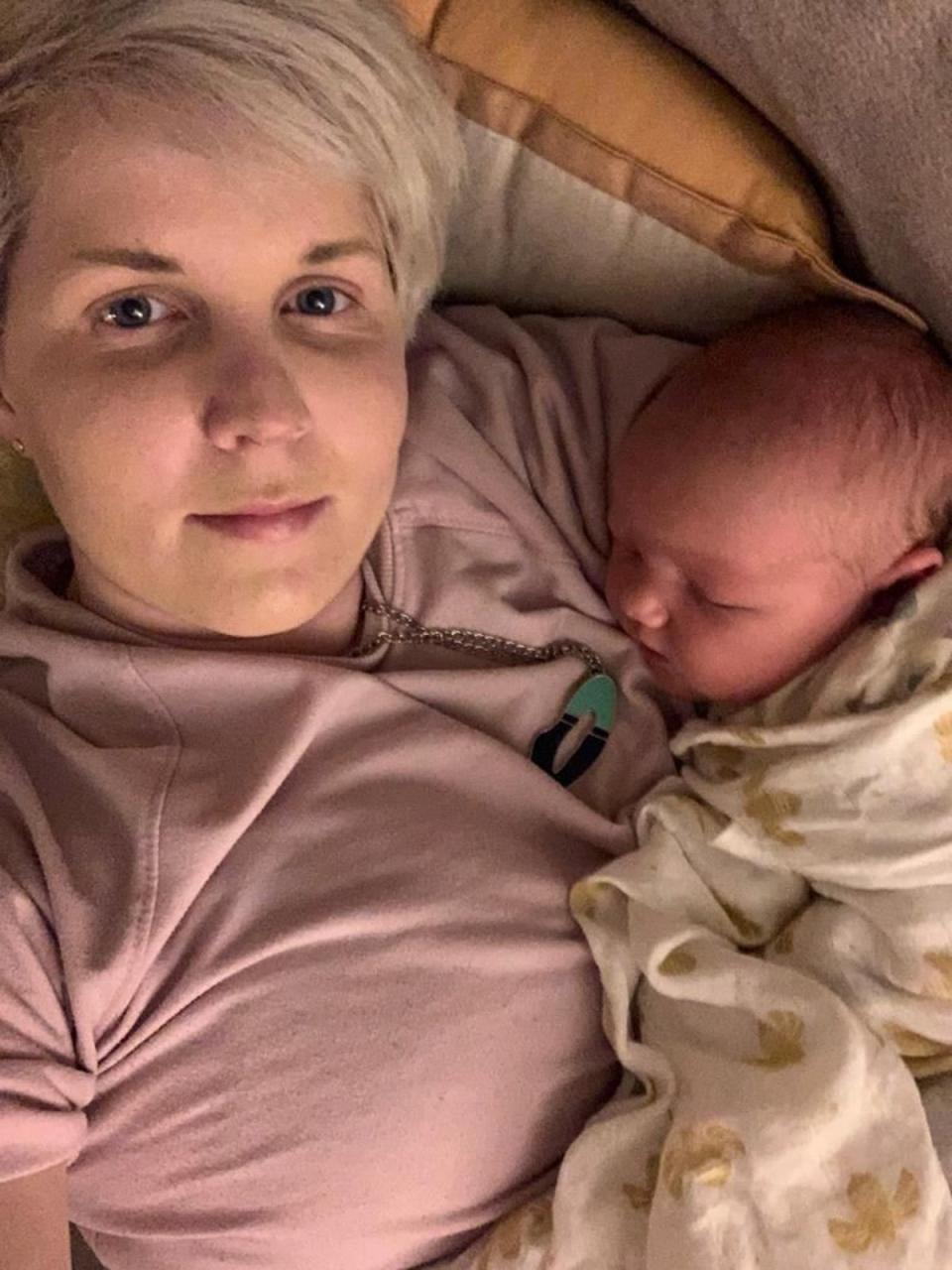Ulez critic whose son has breathing difficulties hits back at Sadiq Khan’s ‘Tories don’t care’ claims

A Tory politician has hit back at claims from Sadiq Khan that opponents of the ultra low emission zone (Ulez) “do not care” about the impact of toxic air on children.
Emma Best, a Conservative member of the London Assembly, reacted furiously to the mayor’s suggestion that her party did not care about the links between pollution, stunted lungs in children and the premature death of adults.
She said it was “crazy” for anyone to make such a personal assertion – revealing that her baby son had spent his first six months of life in and out of hospital with breathing difficulties.
There were angry scenes during Mayor’s Question Time in January when Mr Khan, referring to opposition to his decision to expand the Ulez to Greater London boundary from August 29, said: “The Conservatives clearly do not care about our children developing permanently stunted lungs, and clearly do not care about the premature deaths in our city directly attributable to air quality, because they are in the pockets of vested interests.”
Mr Khan has warned Tory boroughs threatening legal action against the Ulez expansion that they will lose any High Court case.
Ms Best’s son was born in April 2021 – just three weeks before she was elected to the London Assembly.

“In his first month he was really unwell,” she told the Standard. “When I was elected to the London Assembly, my son was not even one month old. I missed the first assembly meeting because I was in hospital with my son, because he was struggling to breathe.
“To suggest that people like me don’t care about children is just crazy. We were in and out of hospital for night stays. Even to this day, we are still trying to work out why he has an issue. I think he will eventually be diagnosed as asthmatic.”
Her son, whose name she wishes to keep private, was treated at North Middlesex hospital, in Edmonton.
She said: “I get so angry with the line that ‘If you don’t agree with Ulez then you want children to have stunted lungs’. This is the thing that makes me furious. One of the things that made me enter politics was air quality.”

She believes the money being spent on the Ulez expansion - £160m for extra cameras, signs and advertising, and £110m for a scrappage scheme – would be better targeted at bigger polluters such as commercial delivery drivers, not occasional motorists.
“I don’t see the point of targeting non-compliant cars that aren’t driven very often,” she said. “That’s normally an older demographic, or people with specially adapted vehicles. These are not the vehicles that are making a massive number of journeys across London.
“You are targeting the wrong cars. You are not targeting the biggest polluters. I think people will question whether a Nissan Micra from 1999 is that much worse than a diesel Range Rover from 2016.”
She described the Ulez expansion as a “very short-term small vanity scheme”. Transport for London admits it expects the zone to raise negligible amounts by 2027 as most motorists will have switched to compliant vehicles by then to avoid the £12.50-a-day levy.
She claimed it would have the greatest impact on low-income suburban Londoners who relied on older cars. Care England has raised concerns about the likely impact on social care workers.
An independent “impact assessment” carried out for TfL, ahead of the mayor’s decision last November to widen the Ulez , predicted the expansion would result in a “moderate negative financial impact” over the short to medium term for people on low incomes travelling into London for work, particularly those in the night-time economy.
Ms Best, who was forced to upgrade her car when the Ulez expanded to the boundaries of the North and South Circular in October 2021, said: “The people in London who didn’t change their vehicles last time are the people who really can’t afford to now, during a cost of living crisis.
“We had a vehicle that wasn’t compliant and we had to change it but that was a really hard thing to do.”
She said the Ulez money would be better spent improving public transport links with the Home Counties, and on better pavements, more trees and school streets and “green walls” at schools to absorb fumes.
According to TfL, the greatest number of deaths related to air pollution are likely to be in outer London.
Though pollution is lower in the suburban boroughs, they are home to a larger proportion of elderly people, and lung function declines with age.
According to TfL’s integrated impact assessment report, which was drawn up by consultants Jacobs, London as a whole breaches the UK’s annual legal limits for nitrogen dioxide (NO2), and has done since 2010. But it meets a NO2 target that is measured hourly.
NO2 is said to be the “main pollutant of concern and at high concentrations causes inflammation of the airways”. Long-term exposure is associated with an increase in symptoms of bronchitis in asthmatic children and reduced lung development and function.
Particulate matter (PM) is the other road pollutant of concern. Long-term exposure contributes to the risk of developing cardiovascular and respiratory diseases, including lung cancer. The smallest particles (PM2.5) are of the greatest concern as they can penetrate deeper into the body.
According to the Jacobs report, London is compliant with both the annual mean and the daily mean limit value for PM10 particles. All London residents live in areas that meet the legal limit value for PM2.5.
However the World Health Organisation (WHO), in September 2021, published tougher guidelines and interim targets for pollution.
A spokesperson for Mr Khan said 98 per cent of London schools were in areas that fail to meet World Health Organisation air pollution limits and about 4,000 Londoners died prematurely every year because of poor air quality.
City Hall said: “Research by Imperial College London shows that the outer boroughs desperately need to tackle this problem: Bromley has the highest number of premature deaths linked to air pollution of all London boroughs – with an estimated 204 lives lost in 2019. In Bexley, it is 162 lives lost, in Harrow 118 lives lost, and in Hillingdon 155 people are estimated to have lost their lives because of conditions linked to air pollution.
“Failing to act in the face of this overwhelming evidence would be a dereliction of the Mayor’s duty to Londoners. The Ultra Low Emission Zone is a targeted measure which will only impact less than one in five vehicles in outer London, but it will keep children out of hospital and save lives.”
The Jacobs report said: “Based on air quality modelling undertaken as part of the London Atmospheric Emissions Inventory, there has been a significant reduction in the number of London residents who live in areas which exceed the UK legal limits (40 µg/m3) for NO2 since 2016, with fewer than two per cent of Londoners (around 170,000) living in areas of exceedance in 2019.
“However, almost a third of London residents live in areas which exceed 30 µg/m3, the level 2 interim target set by the WHO, and all Londoners live in areas which exceed the [PM2.5] guideline limit of 5 µg/m3.
“All London residents live in areas that are within the current statutory PM2.5 UK limits.
“However, more needs to be done to reduce the significant number of Londoners who live in areas exceeding the lowest WHO interim target of 10 µg/m3 and the even lower guideline of 5 µg/m3.
“Although there has been a reduction in Londoners living in areas of exceedance since 2016, 88 per cent of Londoners still live in areas which do not meet the lowest interim target (10 µg/m3), and all Londoners live in locations where concentrations exceed the WHO guideline of 5 µg/m3.”
The report said that although the Greater London Ulez may result in smaller percentage reductions in NO2 concentrations than the original central London Ulez, “in absolute terms there is a much larger volume of NOx emissions saved”.
This was also true of carbon emissions, where there had been a saving of 27,000 tonnes of CO2 in outer London - nearly double that which the central London Ulez achieved in its first year of operation.

 Yahoo News
Yahoo News 
